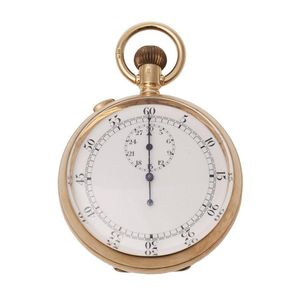18ct Yellow Gold Split-Chronograph Stopwatch by Stauffer, Son & Co
An 18ct yellow gold Split-chronograph Stopwatch, Stauffer, Son & Co. circa 1927. 56.5 mm round case in 18ct yellow gold openfaced with hinged caseback with internal movement dispay crystal winding stem and fob loop at 12 o'clock. Hallmarked as 18ct with London assay office import marks and 1927 'M' hallmark. Case makers mark 'CN' Charles Nicolet. Total weight of watch 126.46 grams. Case back engraving 'W.J Mclean from Elliot R. Davis 'Wharemanea' Ellerslie, June 1941' Hand wound mechanical split chronograph movement, with Swiss lever escapement signed SS&Co and Swiss Made. White dial with Arabic 5 interval seconds makers and railway track scales for seconds and 1/5ths of seconds, minutes totaliser in 12 o'clock subdial. Blue steel index hands. Mineral glass crystal.
You must be a subscriber, and be logged in to view price and dealer details.
Subscribe Now to view actual auction price for this item
When you subscribe, you have the option of setting the currency in which to display prices to $Au, $US, $NZ or Stg.
This item has been sold, and the description, image and price are for reference purposes only.
- Movement - The technical name for the workings of a clock or watch, and does not include the dial or case.
- Lever Escapement - A lever escapement is a type of escapement mechanism used in mechanical clocks and watches to regulate the timekeeping of the movement. It was invented by British clockmaker Thomas Mudge in the 18th century and is now widely used in modern mechanical timepieces.
The lever escapement consists of three main parts: the escape wheel, the pallet fork, and the lever. The escape wheel is a wheel with teeth that is driven by the clock or watch's main spring or weight. The pallet fork is a two-pronged component that is positioned so that it can engage with the teeth of the escape wheel, and the lever is a small, L-shaped component that is attached to the pallet fork.
When the escape wheel turns, one of its teeth pushes against one of the pallet fork's prongs, causing the fork to pivot. As the pallet fork pivots, it releases the tooth and engages with the next tooth on the opposite side of the escape wheel. At the same time, the lever, which is connected to the pallet fork, rocks back and forth, allowing the escape wheel to turn at a regulated rate.
The lever escapement is prized for its accuracy and reliability and is commonly used in high-end mechanical watches. It allows for precise timekeeping by ensuring that the movement of the watch or clock is regulated and consistent, and its compact size makes it an ideal choice for use in small, portable timepieces. - Chronograph - A chronograph is a watch that also incorporates the features of a stopwatch, to measure elapsed time. Most chronographs are operated by two buttons, one to start and stop the chronograph second hand, and the other to return that hand to the starting position.
- Assay / Assayed - Assaying is the testing of a metal, most commonly silver and gold to determine its ingredients and quality. In Britain, once an item of silver or gold has been assayed, a mark is stamped on it, certifying its purity. Known as hallmark, it derives its name from the Guild Hall of the Goldsmiths' Company, who recieved its Charter in 1327 giving it the power to assay and mark articles of gold and silver.
- Circa - A Latin term meaning 'about', often used in the antique trade to give an approximate date for the piece, usually considered to be five years on either side of the circa year. Thus, circa 1900 means the piece was made about 1900, probably between 1895 and 1905. The expression is sometimes abbreviated to c.1900.
This item has been included into following indexes:
- chronographs 690
- pocket watches, case type - open face, gold / gold-plated case 1,381
- pocket watches, country - Swiss made 463
- pocket watches, features
- railways - watches 32
- watches - fob 404
